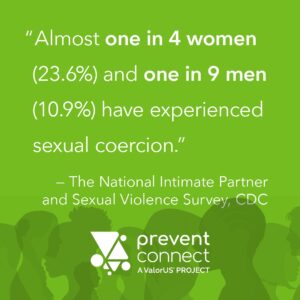New National Intimate Partner and Sexual Violence Survey (NISVS) report released
Today, the CDC released The National Intimate Partner and Sexual Violence Survey: 2016/2017 Report on Sexual Violence that summarizes the prevalence of sexual violence in the United States. Understanding the prevalence of sexual violence is critical for sexual violence prevention efforts. The data provided in NISVS can help practitioners explain the necessity of committing to prevention and can help prioritize target populations for prevention.
- Almost one in 4 women (23.6%) and one in 9 men (10.9%) have experienced sexual coercion.
- Nearly half of women (47.6%) and almost a quarter of men (23.3%) have experienced other forms of unwanted sexual contact.
- One in 4 women (26.8%) and one in 26 (3.8%) men in the United States have experienced a completed or attempted rape in their lifetime.
- A large majority of women and men who experienced all forms of sexual violence knew the perpetrator.
- Rates of sexual violence are highest for American Indian, Alaska Native, and multiracial women.
The report also confirms that sexual violence happens early in life:
- More than 80% of female rape victims experienced rape before age 25, with 49% who were first raped before the age of 18 and 35% first victimized between 11 and 17 years old.
- Likewise, more than 80% of male rape victims were first raped before age 25 including 56.6% who were first raped before age 18 and almost 30% who were first raped between 11 and 17 years old.
Sexual violence has serious immediate and long-term impacts. NISVS confirms that women who reported experiencing sexual violence when compared to those who did not have significantly higher rates of asthma, irritable bowel syndrome, frequent headaches, chronic pain, and difficulty sleeping. Men who reported experiencing sexual violence compared to those who did not reported significantly higher rates of asthma, HIV/AIDS, frequent headaches, chronic pain, difficulty sleeping, and serious difficulty hearing.
The findings contained in this report make clear that sexual violence has serious long lasting public health impacts on communities and society. The data also highlights the need for early and ongoing prevention. Learn more about NISVS here and what works to prevent sexual violence here.

